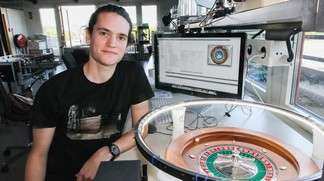A mere ball, a very real mathematical challenge

To what extent could we predict the number on which a roulette ball is going to fall? Philippe Paccaud, micro-technology student, tackled this complex issue in his master's thesis. In the end, there was no miracle equation, but instead a fair dose of ingenuity.
A hunt for the goose that lays golden eggs. This is, in essence, Philippe Paccaud's proposal in his master's thesis, conducted at EPFL's Automatic Control Laboratory. This micro-technology student addressed the question that intrigues more than one mathematician: to what extent can we predict the number on which a roulette ball will fall? He might not have found a miracle equation, but the young man was certainly able to get some interesting results.
He had to be resourceful. He put together a customized experimentation platform that basically consisted of a wheel, a computer and a camera to record the slightest movement of the ball and the position of the number zero slot as a benchmark. To ensure consistency in the light source and thus the accuracy of the detection, the student had the idea to distribute LEDs along an old bicycle rim, which he then suspended above the wheel.
"By means of this system, I executed a thousand throws and recorded all the data to develop a model," explained Philippe Paccaud. Image processing algorithms allowed him to measure the ball and the roulette's position every time. A Kalman filter - a tool for estimating a dynamic system's variables based on partial and/or noisy measurements - was used to assess the speed and acceleration. Then, the database thus created was analyzed by machine learning algorithms. In fact, this is one of the original features of this work, as pre-existing studies on the subject were based primarily on physical models.
A slight tilt
The data collection did entail some difficulties. The student quickly realized that he had to correct a flaw in the wheel: a slight tilt was influencing the ball's trajectory. "A 0.2 degrees difference is enough to bias the results," he explained. There was another difficulty; after starting with 1'400 different data recorded per throw, he ended up with too much information that was simply impossible to analyze. For that reason, he had to reduce them to the most relevant. Finally, Philippe Paccaud also had to ensure the proper positioning of the camera above the game. "It must be placed exactly in the center to ensure an accurate measurement of the ball's position, any mistake could inevitably influence the speed and acceleration estimates."
Once these corrections were made, the student was able to predict with a 43% success rate the baffle (the diamond-shaped metal parts placed around the wooden perimeter, just above the numbered boxes) on which the ball was to hit first. "We could continue this work by testing other algorithms for predicting on which half of the roulette the ball is most likely to stop moving," he notes.
Estimate the area
In conclusion, Philippe Paccaud highlighted the problem's complexity. Not only each throw involves a huge number of variables, but one small parameter variation of the ball (position, speed, acceleration) will completely change the final result, making a prediction of the exact figure, according to him, almost impossible. "One of the algorithms assessed that a difference of 2 inches per second for an initial ball's speed of about 1.3 meters per second (that is: a ~ 0.2% margin) produces the same result, but just outside this range the end result is 10 slots away! One could only speak of the probability to estimate the area of the wheel where the ball will stop."
But these were not the figures that interested Philippe Paccaud the most. "I thought it was particularly rewarding to start from scratch, to create a project from A to Z and to imagine an entire experimentation and analysis system, all of this counting on the teachers' full confidence."
Provided by Ecole Polytechnique Federale de Lausanne



















